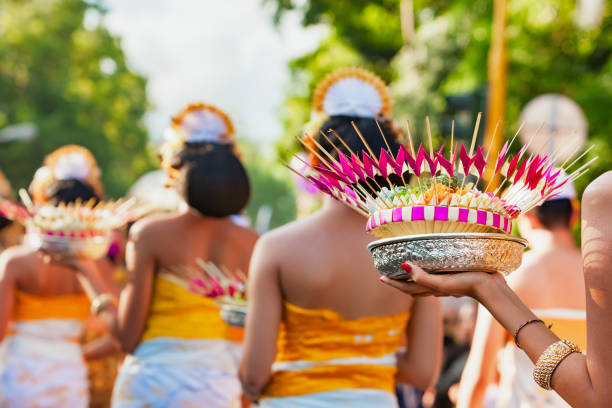Understanding Balinese Daily Offerings (Canang Sari): A Symbol of Gratitude
Balinese daily offerings, known as Canang Sari, are one of the first things you’ll notice upon arriving on the Island of the Gods – small, intricate baskets brimming with color and life. You’ll see them placed carefully on sidewalks, nestled in shrines, resting on shop counters, even sitting on the dashboards of cars. These offerings are far more than just charming decorations, however. They represent a profound and beautiful daily ritual deeply woven into the fabric of Balinese Hindu life.
For many visitors, encountering these lovely offerings everywhere naturally sparks curiosity. What do they mean? Why do people place them in so many different spots? As your friendly guides here at Merusaka Nusa Dua, we’d love to share some insights into this beautiful tradition. Indeed, understanding the Canang Sari can enrich your appreciation for the island’s unique spirituality and help you navigate your surroundings with even greater respect.
Join us as we gently unpack the meaning behind these daily offerings. We’ll explore what they are, what their components symbolize, how Balinese families create and use them, and how you, as a visitor, can appreciate them respectfully.

A Balinese woman in traditional attire respectfully placing a Canang Sari, one of Bali’s daily offerings, at a small household shrine.
What is Canang Sari? The Essence of the Offering
Let’s start with the name itself. “Canang” refers to the small, square tray or basket, which Balinese women meticulously weave from young coconut palm leaves (janur). “Sari” translates to essence, core, or gist. Therefore, Canang Sari essentially means “the essence presented in a small palm-leaf tray.”
Its Deep Purpose: Gratitude and Balance At its heart, the Canang Sari serves as a daily offering of gratitude and a symbolic act intended to maintain balance in the world. Primarily, it’s a thank you extended to Sang Hyang Widhi Wasa, the Almighty God in Balinese Hinduism, for the gifts of life, peace, prosperity, and the harmony of the universe. The offering acknowledges the divine presence woven into everyday life.
Furthermore, Canang Sari often serves a dual purpose. While offered upwards in gratitude to the higher powers, Balinese people also frequently place similar offerings (sometimes slightly different in form, called segehan) on the ground. They intend these lower offerings to appease potentially mischievous lower spirits (bhuta kala), keeping them satisfied so they don’t cause disruption or imbalance. This practice reflects a core understanding in Balinese thought: maintaining equilibrium between the positive and negative forces, the divine and the earthly, the seen and the unseen.
Connecting to Tri Hita Karana This daily practice beautifully embodies the fundamental Balinese life philosophy of Tri Hita Karana. As we explored previously, this means “three causes of well-being.” This philosophy emphasizes achieving harmony through balanced relationships between:
- Humans and God (Parahyangan) – The offering itself connects the individual to the divine.
- Humans and Fellow Humans (Pawongan) – Families often make or share offerings together.
- Humans and Nature/Environment (Palemahan) – Using natural elements like leaves and flowers acknowledges nature’s gifts. Consequently, the simple act of making and placing Canang Sari reinforces this essential quest for balance every single day.
Deconstructing the Canang Sari: Symbolism in Every Element
What makes the Canang Sari so fascinating is that almost every component carries a specific symbolic meaning. While you might see variations, here are the common elements and what they represent:
The Woven Base (Cepèr or Wadah) This is the tray itself, skillfully woven from green coconut leaves (janur). Its square shape can symbolize the earth (known as Ardhacandra) or sometimes represent the larger cosmos (Anda Bhuana). Moreover, the intricate weaving reflects the diligence and artistry inherent in this act of devotion.
Symbolic Rice (Wija) A small sprinkle of uncooked white rice almost always finds its way into the Canang. This represents Sang Hyang Atma – the seed of life, the soul, or the essence of divinity within all living beings.
The Trimurti Bundle (Porosan) You’ll often find a small, significant bundle tucked inside, called the Porosan. It typically consists of three items rolled together in a betel leaf:
- Betel leaf (representing Vishnu, the preserver, often symbolized by green/black).
- Lime (calcium hydroxide, representing Shiva, the transformer, symbolized by white).
- Areca nut (representing Brahma, the creator, symbolized by red). Together, these items symbolize the Trimurti, the three primary manifestations of the one God in Hinduism. Additionally, the porosan also represents the core human faculties: thought (Bayu), speech (Sabda), and action (Idep).
Colorful Flowers (Bunga) The vibrant flowers are perhaps the most eye-catching element. Their colors and placement are often deliberate. Specifically, they represent different Hindu deities and the cardinal directions, creating a symbolic compass of devotion:
- White flowers (pointing East): Symbolize the god Iswara.
- Red flowers (pointing South): Symbolize the god Brahma.
- Yellow flowers (pointing West): Symbolize the god Mahadewa.
- Blue or Green flowers (pointing North): Symbolize the god Vishnu.
- Mixed petals (Kembang Rampai) or a central flower (often placed on top): Symbolize the god Shiva and the integration of all forces in the center. Commonly used flowers include fragrant frangipani (jepun), vibrant marigolds (gumitir), globe amaranth (celosia/ratna), and bougainvillea, though availability influences the exact types used daily. Importantly, the beauty and fragrance of the flowers represent the sincerity and devotion behind the offering.
Sacred Smoke (Dupa) A single stick of burning incense (dupa) typically accompanies the Canang Sari just before the offering ritual. The smoke serves multiple purposes. Firstly, it helps purify the offering and the surrounding space. Secondly, it carries the “sari” or essence of the offering upwards towards the heavens and the deities. Finally, it represents Agni, the god of fire, who acts as a crucial messenger in Hindu rituals.
Other Potential Elements Sometimes, you might notice small additions like a piece of sugarcane, a tiny cookie or cracker, a small coin, or finely shredded fragrant pandan leaves (pandan arum). These additions generally signify material offerings and add further sincerity and fragrance to the devotion.
The Daily Ritual: Making and Placing Canang Sari
The creation and offering of Canang Sari is a graceful, mindful ritual that takes place daily in nearly every Balinese Hindu household.
Daily Creation Traditionally, the women of the household weave the cepèr and assemble the Canang Sari each day. It’s a skill passed down through generations, often performed with a focused, almost meditative quality early in the morning, after household chores and bathing are complete. While people can buy pre-made cepèr at the market, many women still prefer the mindful practice of weaving their own.
The Offering Prayer The ritual itself, known as Mebanten Saiban or Mesaji, requires reverence. The person making the offering (often the female head of the household) will usually dress respectfully in a sarong and sash. The process typically involves these steps:
- First, they sprinkle holy water (tirta), obtained from a temple or blessed spring, onto the Canang Sari to purify it.
- Next, they light the incense (dupa), letting its fragrant smoke rise.
- Then, holding the Canang Sari, often with a flower (sekar) held between the fingertips, they recite prayers (mantra) either silently or softly.
- A gesture of wafting the essence of the offering upwards (using the right hand with a flower) towards the intended recipient (Gods, spirits) often follows. Sometimes, they also waft the essence towards themselves as a blessing.
- Finally, they place the Canang Sari respectfully in its intended location.
Where Offerings Are Placed You’ll find Canang Sari placed in a wide variety of locations, each carrying intention:
- Household Shrines: Small shrines (pelinggih) within every family compound receive daily offerings.
- Family Temples (Sanggah/Merajan): More elaborate offerings grace these important spaces.
- Community Temples (Pura Desa, Pura Puseh, Pura Dalem): Daily offerings are vital here.
- Entrances: People place them at the entrance of homes and businesses for protection and blessing.
- On the Ground: Offerings here, often at intersections, near large trees, bridges, or potentially ‘dangerous’ spots, usually aim to appease lower spirits (bhuta kala).
- Workplaces: You might see them on desks, cash registers, or in kitchens.
- Vehicles: Small ones often adorn dashboards of cars and scooters for safe travel.
- Rice Fields: Farmers make offerings to Dewi Sri, the goddess of rice.
- Beaches/Rivers: People make offerings here to deities associated with water.
Respectful Observation: Etiquette for Visitors
As guests in Bali, appreciating this beautiful tradition involves observing some simple points of etiquette:
- Appreciate the Artistry: Firstly, take a moment to notice the beauty, the intricate details, and the care that goes into each Canang Sari. It’s truly a visible manifestation of daily devotion.
- Do Not Disturb Rituals: Secondly, if you see someone in the process of making or placing offerings, please do not interrupt them, crowd them, or obstruct their path. Observe quietly and respectfully from a polite distance.
- Most Importantly: Do NOT Step Over Them! This is the key practical point for visitors. When you see Canang Sari placed on the ground – on sidewalks, pathways, or entrance steps – please make a conscious effort to walk around them, not over them. Stepping over an offering is considered highly disrespectful. This is because it contains sacred elements and represents a spiritual connection that one should not break or defile by stepping on. Locals navigate these pathways carefully every day; visitors kindly should too.
- Understanding Remnants: After the incense has completely burned out, the Balinese believe the “sari,” or essence, has been received. Consequently, the physical components have served their purpose. This explains why you might see offerings being swept up later in the day or disturbed by animals or daily foot traffic. While intentional disrespect is never acceptable, understanding this helps clarify why remnants aren’t always treated with the same reverence after the ritual concludes. Please don’t be concerned if you see swept-up offerings.
- Photography Etiquette: If you wish to take photos, especially close-ups of people making offerings, it’s always polite to ask for permission first. A smile and gesturing towards your camera usually works. When photographing offerings in public spaces, do so discreetly and respectfully.
A Window to the Balinese Soul
The humble Canang Sari represents so much more than just a pretty arrangement of flowers. It acts as the daily heartbeat of Balinese culture. Furthermore, it serves as a constant, visible reminder of gratitude, a commitment to balance, and a deep connection to the spiritual world that permeates every aspect of life on this unique island.
By understanding a little about their meaning and significance, and by observing the simple etiquette of not stepping over them, you show profound respect for the local culture. Ultimately, appreciating this daily ritual truly opens a window into the beautiful spiritual heart of Bali.
You’ll even notice these thoughtful offerings placed carefully around our resort here at Merusaka. They serve as a gentle reminder of the living traditions that make Bali so incredibly special. We hope this guide enhances your appreciation for them during your stay.



